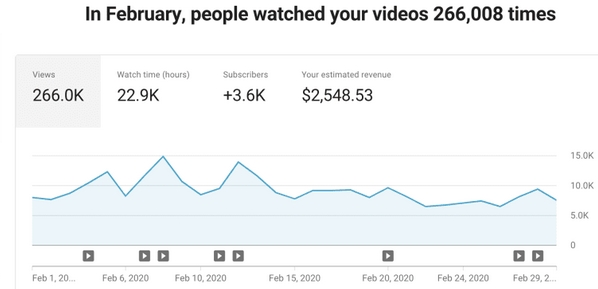YouTube monetization is a hot topic for content creators and aspiring influencers alike. As the platform constantly evolves, understanding the ins and outs of earning money from your videos can significantly impact your success. At its core, YouTube monetization allows creators to earn revenue primarily through advertisements, sponsorships, and merchandise sales, among other streams. So, what does it really take to make money on
The Factors Influencing YouTube Earnings

When it comes to YouTube earnings, not all views are created equal. Several crucial factors influence how much revenue a channel can make from those 100 million views. Let’s break them down:
- Ad Revenue: This is the bread and butter of YouTube monetization. The amount earned varies greatly based on:
- Geography of viewers (some regions have higher CPM rates)
- Ad formats (display, overlay, skippable, etc.)
- Seasonality (holiday periods often yield higher ad rates)
- Audience Engagement: How engaged is your audience? The more they like, share, and comment on your videos, the more likely your content will be promoted by YouTube's algorithm. Higher engagement can lead to:
- Longer watch time, which boosts rankings
- More exposure to lucrative ads
- Niche Topics: Different niches attract different advertisers, and some may pay significantly higher than others. For instance, finance and tech typically command higher CPMs compared to general lifestyle channels.
- Content Type: Educational, how-to, or product reviews often attract more advertisers, while certain types of video content may have restrictions.
- Brand Collaborations: Beyond ad revenue, influential creators often partner with brands for sponsorships, which can significantly inflate earnings. Depending on your audience size and engagement, sponsored content can become a major income stream.
In summary, to maximize YouTube earnings, it’s essential to understand these factors and strategically optimize your content and audience engagement accordingly. The road to monetization is layered, but with the right approach, those 100 million views can translate to substantial financial gain!
Also Read This: Step by Step Guide to Uploading an Illustrator File to Behance
Estimating Income from 100 Million Views

When it comes to estimating income from a whopping 100 million views on YouTube, things can get a little tricky. The income you might earn from that number can greatly vary depending on several factors. One of the most significant factors is the monetization method used, usually through YouTube's Partner Program. But let’s break it down a bit!
Typically, YouTube creators earn via AdSense, where ads displayed during their videos generate revenue. The rate? It varies, but a common metric is CPM (Cost Per Mille), which is the amount an advertiser pays per 1,000 impressions. Depending on the niche, CPM rates can fluctuate, often ranging from:
- $1 to $3 for lower-end niches,
- $5 to $10 for mid-range audiences, and
- $10 to $30 or higher for lucrative niches like technology or finance.
Let’s do some quick math to get an idea of potential earnings:
| CPM Rate | Estimated Income for 100 Million Views |
|---|---|
| $1 | $100,000 |
| $5 | $500,000 |
| $10 | $1,000,000 |
| $30 | $3,000,000 |
So, as you can see, the estimated income can be anywhere from $100,000 to $3 million, depending on the CPM rate. Keep in mind, though, that not all views are monetized, which can further affect your earnings!
Also Read This: Building a Successful Portfolio on Adobe Stock: Tips for Capturing Market Demand
Ad Revenue vs. Other Income Sources
When discussing YouTube earnings, it’s easy to focus solely on ad revenue. But let me tell you, there’s a whole smorgasbord of income sources creators can tap into! While ad revenue is a significant piece of the pie, here’s a look at the other revenue streams that can substantially boost your earnings:
- Sponsored Content: Many creators partner with brands to feature their products in videos, raking in hefty fees.
- Merchandise Sales: Selling branded items like t-shirts or mugs can provide a nice additional income.
- Channel Memberships: Some creators offer exclusive content for members at a monthly fee, creating a steady income.
- Affiliate Marketing: By promoting other companies’ products and earning a commission on sales, creators can enhance their income.
- Crowdfunding: Platforms like Patreon allow fans to support creators directly, providing a reliable revenue stream.
It’s important to diversify your income! Relying solely on ad revenue can be risky due to factors like changes in YouTube policies or fluctuations in ad rates. By combining ads with other income sources, creators can achieve much more stability and financial growth.
Also Read This: How to Glue Images to Glass Cabochons for Craft Projects
5. Case Studies of Successful YouTube Channels
When talking about YouTube earnings, it’s essential to look at real-world examples to understand how channels manage to monetize their content and achieve staggering view counts. Let's delve into a few case studies that showcase how successful YouTube channels have navigated this thrilling digital landscape.
1. Ryan's World: Starting as a simple toy unboxing channel, Ryan's World has exploded into one of the highest-earning YouTube channels. With over 35 million subscribers and billions of views, Ryan's parents smartly capitalized on his popularity, expanding into merchandise like toys and clothing. The channel's estimated earnings of $30 million in one year exemplify how niche markets can generate substantial revenues.
2. Dude Perfect: This channel was born from a group of friends who wanted to share their amazing trick shots and sports-related content. Their unique blend of humor, sports, and skill led to rapid growth, accumulating over 59 million subscribers. They also leverage sponsorship deals and live events, earning around $20 million annually. Dude Perfect’s business acumen goes beyond just ad revenue!
3. T-Series: A powerhouse in the music domain, T-Series is a prime example of how diverse content can attract viewers. With over 200 million subscribers, the channel primarily shares music videos, earning millions through ad revenues and partnerships. Their strategy revolves around high-quality content that appeals to a wide audience in India, proving that regional content can be incredibly profitable.
These case studies illustrate that success on YouTube can take many forms—whether it's content focused on toys, sports, or music. Diversifying revenue streams, maintaining a consistent upload schedule, and engaging with your audience are common threads among them. Inspired? You could be next!
Also Read This: How to Add Motion Templates in Adobe Stock
6. Tips to Maximize YouTube Revenue
Now that we understand how some channels make the big bucks let's discuss practical tips to help you maximize your YouTube revenue! Whether you’re just starting or looking to scale up, these strategies can help your channel thrive financially.
- Focus on Quality Content: Always prioritize creating high-quality, engaging videos that resonate with your audience. Invest in good equipment and editing tools to produce visually appealing content.
- Optimize for SEO: Use relevant keywords in your video titles, descriptions, and tags. This step enhances your discoverability and ensures people can find your content easily.
- Engage with Your Audience: Foster a strong community by responding to comments, asking for feedback, and holding Q&A sessions. Engaged viewers are more likely to share your content, boosting views.
- Diversify Your Income Streams: Don’t just rely on AdSense. Consider affiliate marketing, sponsored videos, merchandise sales, and crowdfunding through platforms like Patreon to increase earnings.
- Utilize YouTube Analytics: Regularly check your analytics to understand what's working and what's not. Look for patterns in your viewer demographics, watch time, and traffic sources to tailor your content.
Remember, growing your YouTube revenue takes time and patience. By combining these tips with creativity and hard work, you'll be well on your way to maximizing your income from your channel. Happy creating!
Also Read This: Follow This Step-by-Step Tutorial on How to Upload Music to Bandcamp App
Understanding YouTube Earnings for 100 Million Views
YouTube has become a lucrative platform for creators, allowing them to generate significant incomes based on viewership. When it comes to understanding YouTube earnings, particularly for reaching the milestone of 100 million views, various factors come into play. Here’s what you need to know.
The primary revenue source for YouTube creators is through advertisements, calculated via Cost Per Mille (CPM), which refers to the amount earned for every 1,000 ad impressions. It’s essential to identify that CPM rates can vary immensely based on several factors including:
- Geography: Viewers from countries like the USA, Canada, and Western Europe typically yield higher CPM rates.
- Content Category: Certain niches, such as finance or technology, generally command higher CPMs.
- Audience Engagement: Videos with high engagement (likes, comments, shares) can attract better ad placement.
On average, YouTube creators earn between $0.25 to $4.00 per 1,000 views, though it can sway based on the aforementioned factors. To give a clearer picture, here’s a simple table illustrating potential earnings:
| CPM Rate ($) | Earnings for 100 Million Views ($) |
|---|---|
| $0.25 | $250,000 |
| $1.00 | $1,000,000 |
| $2.00 | $2,000,000 |
| $4.00 | $4,000,000 |
These figures can also be influenced by supplemental income streams such as sponsorships, merchandise sales, and affiliate marketing. YouTube’s Creator Program offers further potential earnings for active creators.
Conclusion and Key Takeaways
The earnings for 100 million views on YouTube can vary widely from $250,000 to $4 million depending on CPM rates, audience geography, content niche, and engagement levels. Understanding these parameters can help creators strategize for greater monetization opportunities on the platform.
 admin
admin








